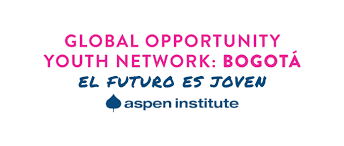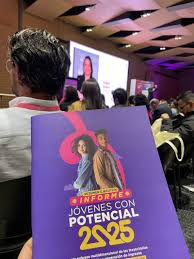By Global Opportunity Youth Network
GOYN Bogotá
The Young People with Potential 2025 Report reaffirms its commitment to highlighting the structural barriers and injustices that young people face in their connection to opportunities. The report is an evidence-based tool for decision-making by ecosystem stakeholders, aimed at driving systemic transformations in the city.
The report presents a summary of Chapter 4, focusing on youth participation and leadership, which responds to GOYN's strategic value of youth voice.
Youth leadership in Bogotá
The report states defines leadership from three perspectives: as the ability to mobilize people to address common challenges, as public leadership aimed at generating collective value through inclusive processes, and as youth leadership exercised by young people in their formative stages with the potential for social transformation.
In Bogotá, of the 377 young people surveyed, only 16.71% of the respondents identified themselves as leaders. The majority were women, between the ages of 21 and 24, from social classes (social strata 2 and 3). The majority studied or worked, and were concentrated in urban areas such as Suba, Kennedy, Engativá, and Ciudad Bolívar. Youth leadership was primarily exercised in urban areas, although 7.91% of the respondents came from rural areas, where significant leadership was also found.
Of young leaders, 71,414,000 are actively involved in civic spaces, especially in youth groups, NGOs, and foundations, rather than institutional bodies such as youth councils. While they manage to mobilize communities and generate transformation, their impact on public decisions remains limited.
The majority express high levels of personal satisfaction with their leadership. More than half have received training on the subject, and financial resources, training, and mental health care are identified as facilitators. Among the main obstacles are a lack of personal resources and institutional barriers such as bureaucracy or exclusion from participatory spaces.
Finally, young people trust social organizations (NGOs, youth groups) more than institutions such as the police, churches, or the national government, which reveals a challenge in strengthening institutional legitimacy and generating real mechanisms for youth participation and impact.
The Report distinguishes two major approaches to leadership.
On the one hand, the individual leadership, focused on the characteristics and skills of specific people, from which styles such as charismatic (based on personal inspiration), transactional (based on incentives and rules) and transformational (which promotes shared vision and the formation of new leaders) are derived.
On the other hand, the collective leadership, which understands leadership as a shared process that arises from social interaction, giving rise to forms such as distributed leadership (responsibilities according to talents) and collaborative leadership (based on dialogue, trust and horizontality).
These styles are not mutually exclusive and are often combined in practice. Among young people in Bogotá, collaborative and transformational leadership predominate, characterized by participatory construction, listening, and the democratization of power.
Also highlighted are Challenges to strengthen youth leadership: Integrate mental health as a pillar of sustainability, highlight rural leaders who face greater barriers, collaborate with organizations trusted by young people (NGOs, foundations, youth platforms), and align resources toward priority causes such as education, culture, art, and sports, without neglecting less-visible issues such as disability and mobility.
Leadership competencies are classified into three groups: semotional and relational leisure (relationship with oneself and with others), cognitive (knowledge to read the environment and act strategically) and integrative (articulation of emotional and strategic knowledge). These skills are cultivated through practice, reflection, and support.
Comparative analysis shows that young leaders exhibit higher levels of resilience, openness to dialogue, and influence than those who only participate or do not participate, although weaknesses in self-care and emotional regulation persist.
In integrative competenciesLeaders excel in teamwork and service-oriented behavior, while non-participants show the lowest levels. In the cognitive realm, leaders excel in systemic thinking, evidence-based decision-making, and territorial recognition, although they still face challenges in technological appropriation and public awareness.
Conclusion
Youth leadership develops key competencies for social mobilization and transformationTo strengthen it, the following are required: for non-participating youth, working on basic socio-emotional skills; for participants without leadership, strengthening integrative skills such as networking and communication; and for established leaders, reinforcing self-care, systemic thinking, and public awareness. This will allow us to move toward sustainable, strategic leadership with greater social impact.
10 KEY FACTS
1. Between 2019 and 2024, the number of young people in Bogotá fell from 1,972,030 to 1,830,889, representing a 7.21% drop, the highest among capital cities with the largest youth population.
2. In 2024, there were a total of 520,911 Young People with Potential in Bogotá, representing 28.41% of the total number of young people in the city. Disengagement varies according to life stage: between the ages of 14 and 21, young people who neither study nor work predominate, while from ages 22 to 26, the problem ranges between young people who neither study nor work and young people in the informal labor market. From age 26 onward, informal labor prevails.
3. In Bogotá, 14% of youth between the ages of 18 and 28 (96,560 people) completed secondary school without continuing on to secondary education, which hinders their return to traditional formal education and restricts the development of key skills to improve their job placement opportunities.
4. In Bogotá, 31% young people between the ages of 24 and 29 (218,225 people) disconnect after the average, a situation that, when prolonged, closes the doors to quality jobs, perpetuating structural inequality and keeping many trapped in informality and vulnerability.
5. Although the immediate transition to higher education has improved slightly in recent years—from 46.6% in 2019 to 52.2% in 2023—total enrollment has remained stable since 2018, at around 1.6 million students.
6. Regarding the unemployment rate, young people register a 17.41% unemployment rate compared to 7.41% unemployment rate for non-young people. This difference means that their likelihood of being unemployed is 2.3 times higher, highlighting the particular vulnerability they face when faced with difficulties in generating income.
7. 73.11% of young business owners do not make health or pension contributions, which leaves them vulnerable to illness, accidents, or old age, and limits their access to institutional safety nets.
8. Of the youth entrepreneurships, 86% are not registered with the Chamber of Commerce, 70% do not have a Tax Identification Number (RUT), and 55% do not keep accounting records. This last percentage represents more than 27,000 young people who would be excluded from key opportunities such as access to the financial system, limiting their ability to grow their businesses to more advanced stages.
9. Financial support is the main facilitator of youth leadership: 8 out of 10 young leaders who responded to the survey indicated it as a key factor in promoting their initiatives and exercising their leadership role.
10. Among the 377 young people who responded to the survey, 631% of respondents did not know what Local Youth Councils (LYCs) were. This lack of awareness is not limited to those who are not involved in participation: it is also reported by 31.7% of young leaders, 54% of those who participate without leading, and 78.7% of those who do not participate in any forum. This reflects a structural challenge in disseminating and connecting LYCs with youth realities.
NOTE: See Chapter 4 or the full report at Informe-Jovenes-con-Potencial-2025-GOYN-Bogota_compressed.pdf






